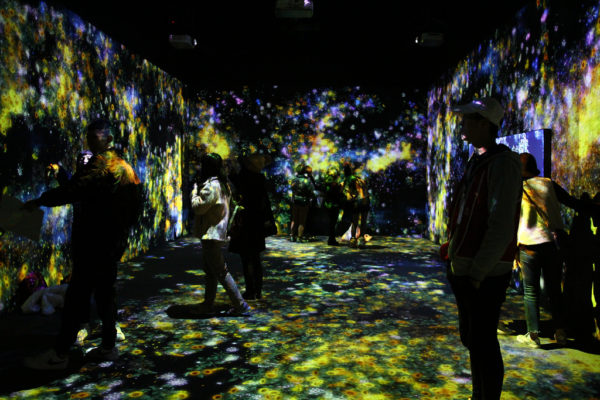TeamLab’s work merges art and technology to question human relationships with the natural world. Bringing together artists, programmers, engineers, computer animators, mathematicians and architects, they aim to “liberate art from the physical and transcend boundaries,” according to Sakai.
I first encountered teamLab at Mori Art Museum’s “The Universe and Art” exhibition in Japan. I was struck by how their digital installation transformed a once-familiar museum space. The movement of lights, pulse of the soundtrack and projection of graphics on all surfaces of the room made me feel like I was floating in space.
Initially we perceive ourselves as viewers at the center of these revolving digital objects, but soon we feel immersed and shift from being an audience member to a participant, floating around the images, without a static point of reference. This shift in perception can be relaxing, as we release the need to ground ourselves in a certain perspective or reality. Regardless of how we situate ourselves in relation to the artwork, we inhabit it.
Sakai explained the transformation of our interaction with art through the use of digital technology by contrasting teamLab experiences to modern experiences with Leonardo da Vinci’s “Mona Lisa” in the Louvre, an art museum in the heart of Paris. In the Louvre, visitors crowd around the small portrait, attempting to take photos and selfies. There is tension between visitors as they fight to see the work.
In teamLab’s immersive spaces, the presence of others is an opportunity to see beyond individual interactions. Visitors add to the beauty and complexity of the artwork, thereby creating a diversity of visual stimuli. For example, when Sakai’s friend was tired he laid down and slept in the exhibition for two hours. While in traditional exhibits this would be unimaginable, in teamLab’s work this allowed hundreds of digital flowers to gather around his body.
Museum etiquette often dictates that children should be quiet and refrain from running, but in teamLab’s creations, children are encouraged to interact with the art, and their spontaneity is admired rather than criticized. For example, in teamLab’s installation “Sketch Aquarium” (2013) children draw their own fish which, upon scanning, can be projected into an ever-expanding digital aquarium. Children interact with their artwork, feed the fish and see their fish coexist with the creations of others.
teamLab has also applied their digital technology to contexts beyond conventional art spaces. In the installation “An Office Where Animals Live” (2017) visitors are led to a meeting room by a live digital animal, enriching everyday professional experiences and broadening contexts in which art can exist.
teamLab even collaborated with a Tokyo-based restaurant Sagaya to create an interactive, multi-sensory space where art, food, sound and crockery combine to convey the beauty of Japan. Birds may perch on a diner’s hand, flowers may bloom under a plate and this world that is projected via digital mapping, enchanting animation and new sensations surprises the diner at every moment.
teamLab harnesses the power of digital technology to create spaces that embrace collaboration, interaction and experimentation. Their work dances between real and imaginary to free us from conventions, highlight the elegance of the natural world and remind us of the beauty of human interactions made visible.
Source: https://www.stanforddaily.com













